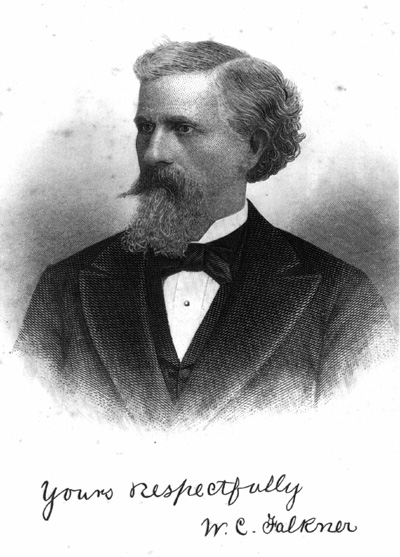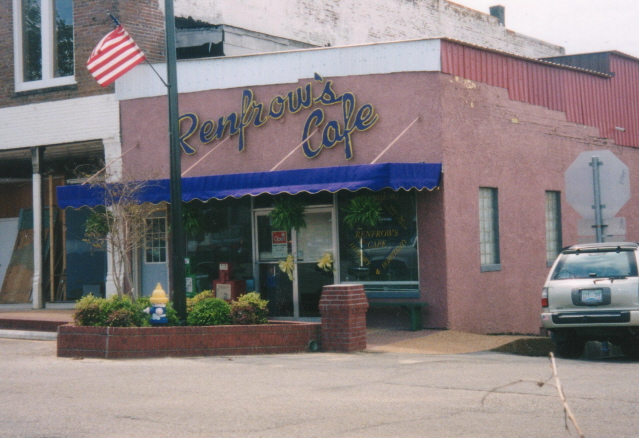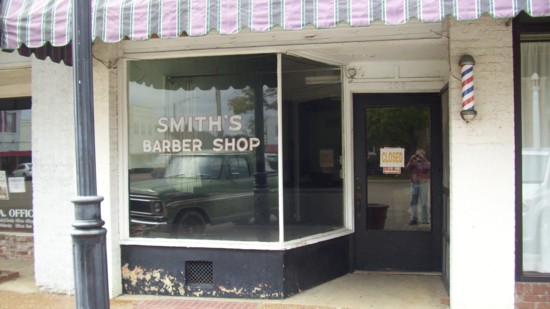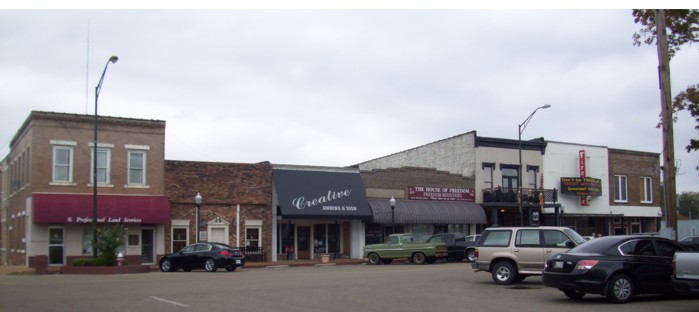

by Jack D. Elliott, Jr. - February 2012
being in front of Renfrow's Cafe, believed to be the site
of Thurmonds office, at the northwest corner of the square.
A re-examination of the evidence indicates that this is
not correct. The actual site is somewhat more than
100 feet to the south, where R J Thurmond's office was
really located.


The Falkner Monument, Ripley
Cemetery
My other memory was of the purported site where
Colonel Falkner was shot by Thurmond outside the latter's office. On the 1974 field trip,
we were told that Thurmond's office had stood on the site of what was then
Renfrow's Cafe
on
the northwest corner
of
the square.[1]
This
identification continued to be made for decades until evidence
began to arise suggesting that it was not in fact the correct
site.


C.M. Thurmond's office, 1881-1937
Used by C M Thurmond for a law
office, 1882-1900. Misidentified in recent years as the office
of his father, R J Thurmond.
Alexander & Co.
The primary partner in
the
firm
of Alexander & Co. was Dr. Eli Marion
Alexander,[6] who had been in business in Ripley as early as
1856, initially in the drug store partnership of Cox &
Alexander. He left that partnership in 1858 [7] while continuing to practice medicine. After the Civil War he was again in
the drug business. About 1870
along with Dr. John Y. Murry, he was in the
drug store partnership
of Murry & Alexander,
[8] while somewhat later he was in the partnership
of Alexander & Hunt
along with his brother-in-law, Dr. EN Hunt.[9] About 1874 Alexander left the drug business and joined the partnership Bell, Alexander & Co. which was variously listed as a dry goods store and a general store.[10]
By 1879 Alexander's business was listed as Alexander & Co.
and under this name it operated until
July 1895,[11] when he was stricken with paralysis[12] and retired from business, selling out to J.A. Norriss & Co which carried an advertisement in September announcing that they had “purchased the stock of Alexander & Co., on West Side [of the square].”[13]
Alexander
&
Co.
move
into
the
brick
Wm.
R.
Cole
store
building
Throughout the 1880s and 1890s Alexander & Co. were located on the west side of the square. However, the firm never owned a lot there, indicating that they rented the buildings used. During the early 1880s the location on the west side is unknown although the process of elimination suggests that it was on Lot 4 Block 17.[14]

Plat of part of Ripley around the square. Lots are 49.5 x 99 feet.
William R.
Cole Store
Building
Shortly after the 1856 fire, Cole purchased the northern portion of the adjacent Lot 8 Block 17
where Orlando Davis's law office had been located before the
fire.[23] Cole then presumably built another store, which was also apparently burned during the Civil War along with all the businesses
on the square in conflagrations set by Union troops on 23 March 1863 and
on 8/9 July 1864.[24] Soon after the end of
the war, he presumably built the brick store under discussion, that is in
about late 1865
--1866. Because Cole owned both the south half of Lot 5 and the adjacent northern portion of Lot 8,
he was able to construct the brick building straddling the line between the two lots.
Cole sold his store and lot in 1874 to R J Thurmond and may have moved to Colorado at this time.[25] However, his business in Ripley continued to be listed in the credit reference books through 1880. If he continued in business this late before going to Colorado, then he was certainly having to rent which would seem improbable for an established merchant used to owning his own business house.
Regardless, by 1880 Cole had moved to Colorado and his brick store was being rented by late 1880 to L H Elliott & Co. After this firm vacated, the building was occupied by Alexander & Co. in September 1883 as established above.
Subsequent deed records during the early twentieth century continued to describe this property as the “brick building known as the Bill Cole store” and variants.[26] At an undetermined time—probably between the world wars—the old facade was removed and a new one was constructed of pressed brick with striated surfaces. However, today it is very easy to see where the new facade joins to the older, hand made bricks that constitute the side walls of the building. After surveying all the evidence, both archival (deeds and maps) and extant architectural remains, it is now clear that the brick walls of the Cole store building, used by Alexander & Co. in 1889, still stands and are part of the present business, Creative Awning and Sign. Except for the facade, which is a twentieth century replacement, the brick walls are the oldest components of commercial architecture on the Ripley public square. By my measurement the facade is about 21 feet wide (north-south). While most (18 feet) of this is on the southern half of Lot 5 Block 17, it does extend three feet over onto the northern edge of the adjacent Lot 8 B17.[27] This building--the only brick store on the square in 1889--still stands and is the only commercial building remaining there from the time of Colonel Falkner. It is the building that editor R F Ford referred to as being at or near the site of the shooting.
 |
 |
 |
Four years later with the installment of a new President, Simpson was removed from office again, and the postmaster-ship went to George W. Autry, a Ripley merchant engaged in the sale of confections and beer.[33] Autry's place of business was apparently on the north half of Lot 8 Block 17, which is to say, on the south side of Alexander & Co.'s store, and there he presumably located the post office, so it could be run in conjunction with his business.
This left E W Simpson's small post office building vacant. On October 10, 1889, the Southern Sentinel carried an item which provided the final evidence for when and where R J Thurmond established his office: “Mr. R J Thurmond has opened an office in the old post office. He has a neat, cozy, little office.” With this the stage was set: Alexander & Co. in the brick building and on its north side, R J Thurmond in the small frame office building. Twenty-five days after the newspaper item was published, R J Thurmond shot Colonel Falkner in front of this office.
Item from the
Southern Sentinel, 10 October 1889.
The
west side of the square in
Ripley from the 1925 Sanborn
Insurance Map, with key
locations relevant to the
shooting.
Several buildings were still
surviving in 1925 from the
1880s, including all the
frame buildings and all
three of the buildings that
are labeled. Yellow coloring
indicates frame
construction, and red
indicates brick
construction. Note that the
R J Thurmond office has both
red and yellow coloring,
although the building was
constructed as a frame
building. However, in 1905
while the office was being
used as a barber shop, a
brick annex
was added for a bath house,
making it both a frame and
brick building. (Southern
Sentinel, 30 March
1905)

Smith's Barber Shop in the
southern portion of the McAlister building--
the site of R.J. Thurmond's office in November 1889
However, during the late 1880s efforts were made to provide brick sidewalks connecting the stores around the square so that customers could get about with relative ease. Initially this was not a corporate effort but usually conducted by individual merchants providing pavement in front of their respective stores. If enough contributed sections of pavements, the result would be a continuous pavement. On 23 May 1889, the Southern Sentinel reported that “Mr. G M Bostwick has put in good condition the walk in front of his business house. Mr. Phyfer and Judge Worsham, say they will repair their pavements soon. When this is done Main Street will have a solid brick walk from one end to the other.” In other words, by May 1889 practically all of the west side of Main Street on the square including in front of the Alexander & Co. store and Thurmond's office had been paved with brick. This corroborates the accounts that refer to Falkner's being on the pavement and thereby close to the front of Thurmond's office.
The newspaper accounts of the shooting of Colonel Falkner appear
to be reliable. The two places mentioned—R J Thurmond's office and
Alexander & Co.'s store—by virtue of being adjacent to one
another effectively corroborate one another in placing the crime
outside of Thurmond's office on the brick sidewalk. The building
used by Alexander & Co. still survives, although greatly
modified, especially the facade. Thurmond's office, of frame
construction, was torn down in 1929 and replaced with the present
brick structure, part of the McAlister building that in recent
years housed the Smith barber shop.
I would like to thank those who without fail were always happy to provide assistance: Tommy Covington, Melissa McCoy-Bell, Melinda Marsalis, Bruce Smith, and the staffs of the Ripley Public Library, the Southern Sentinel, and the Tippah County Chancery Clerk's Office.
End notes:
1. Renfrow's Cafe was a brick building that was constructed in 1937 and burned on 12 October 2011. In legal terms, it stood on the north half of Lot 1 of Block 17 in the plat of Ripley.
2. The small frame building was constructed in late 1881-early 1882 and served as CM Thurmond's law office until his death in 1900. For the construction of the law office see the following:
Southern Sentinel, 1 Dec 1881: “Mr. CM Thurmond…has bought the lot on the corner north of Murray’s [sic] Drug Store where he intends to put up a law office.”
On 18 Nov 1881, CM Thurmond purchased the north 20 feet of Lot 1 Block 17 from JE Rogers, see Tippah County Deed Book 6/618.
Ripley Advertiser, 17 Dec 1881: “Mr. CM Thurmond is building a new law office on the northwest corner of the square. The foundation is laid and a portion of the frame work is already erected.”
Southern Sentinel, 9 Feb 1882: “CM Thurmond, Esq., will also, soon be ready for occupancy. It is a handsome building and reflects credit upon the architect.”
Southern Sentinel, 17 Dec 1908: “City Barber Shop. JE Bryan, Prop’r. located in the 'old Thurmond' office, just vacated by Pegram & Street [attorneys].” CM Thurmond's heirs sold his office to Thomas E. Pegram on 8 Oct 1909, Tippah County Deed Book 19/261. Pegram then sold the property to Dr. JD Burns on 16 Oct 1909. Tippah County Deed Book 19/262.
Southern Sentinel, 17 June 1909: “Dr. JD Burns has bought the 'Thurmond office' now occupied by JE Bryan, barber, on northwest corner square. He will move into it in a few weeks and expects to put it in first-class condition for an up-to-date dental parlor.”
Southern Sentinel, 28 April 1921: Weekly advertisement, “J.D. Burns, Dentist/Office in Thurmond House/North West Corner square.” The same ad was still running in the Sentinel as late as 12 Aug 1926.
Southern Sentinel, 6 April 1933: “The City Barber Shop...has moved...to the building formerly occupied by Dr. JD Burns on the northwest cor[ner of the square.]”
Southern Sentinel, 10 June 1937: “Pleas Renfrow expects to begin the construction of a building on the Street lot at an early date….” Oscar F. Street purchased the Thurmond office, north ½ Lot 1, Block 17, on 19 Sept 1929. Tippah County Deed Book 36/172.
Southern Sentinel, 22 July 1937: “Renfrow's Cafe, which is owned and operated by Mr. and Mrs. Pleas Renfrow, is being moved into a new brick building on the northwest corner of the square, on the west side of main street. They have recently constructed a building on the lot there which they leased from OF Street.”
7. Ripley Advertiser, 16 May 1856: advertisement, “Drs. Moody & Laird. Office first door North of Drs Cox & Alexander’s Drug Store”; Ripley Advertiser, 3 Mar 1858: Item to the effect that Dr EM Alexander has sold his interest in drug store of Cox & Alexander. “Our books will be found with COX & FOSTER at the old Stand, who will continue the Drug business.”
8. Bradstreet credit reference book 1870.
9. Mercantile Agency/R G Dun & Co, credit reference books, 1873, 1874. Both men were married to Sperry sisters from Virginia. Hunt was a nephew of R J Thurmond and would later marry Lizzie Murry Burns, who was a daughter of Dr. J Y Murry and a great-aunt of William Faulkner.
10. Mercantile Agency/R G Dun & Co, credit reference books, 1874, 1875, 1877, 1878. In 1874 the store was listed as dry goods, while subsequent entries listed it as a general store.
11. Alexander & Co. is listed in the Mercantile Agency/R G Dun & Co, credit reference books as a grocery store in 1879, 1880, 1881, 1882, 1883, 1884, 1885, 1886, 1887, 1888, 1889. Bradstreet credit reference books for 1890, 1892, 1893, 1895 continue to list the business, identifying it as a general store in 1890-1893 and as a grocery and hardware store in 1895.
12. Southern Sentinel, 25 July 1895: “Dr. E.M. Alexander was stricken with paralysis one day last week and now lies at his residence in a helpless condition….”
13. Southern Sentinel, 19 Sept 1895. Dr. Alexander subsequently recovered as indicated by the following: Southern Sentinel, 15 Oct 1896: “Our people are rejoiced that Dr. Alexander is again able to walk over town.”; Southern Sentinel, 23 Sept 1897: “…Dr. Alexander…is again able to attend to business. He may be found at his old stand, with J A Norriss & Co.”
14. Southern Sentinel, 6 Jan 1881: “NEW HARDWARE STORE! ALEXANDER & CO/West Side Public Square”; Southern Sentinel, 26 Oct 1882: “Alexander & Co, Staple and Fancy Groceries, Hardware, stoves, tinware, boots, shoes….West Side Public Square.”
15. Ripley Advertiser 15Sept1883; see also Southern Sentinel, 13 Sept 1883, for a similar account.
16. Southern Sentinel, 4 Sept 1884.
17. Southern Sentinel, 3 Oct 1889.
19. A reminiscence by editor RF Ford in the Ripley Advertiser 15 Jan 1881 indicates that Cole was already in business when Ford arrived in town in 1849; Cole is listed in the 1850, 1860, and 1870 censuses as a merchant in Ripley. In the 1880 census he and his son William D. were listed as grocers in Pueblo, Colorado.
21. Tippah County Deed Book C/248.
22. Andrew Brown, History of Tippah County: The First Century, 1998, page 44.23. Tippah County Deed Book Q/485.
24. Brown, History of Tippah County, pages 119, 140-141.
25. Tippah Co Deed Book 2/623.
26. Tippah County Deed Books 22/147; 22/165; 22/289; 26/250; 28/176; 28/394; 30/30; 31/23.
27. See deeds that refer to Cole owning 12.5
feet on the north side of Lot 8. Tippah County Deed Books Q/485; 2/623.
29. Southern Sentinel, 9 June 1881: “Mr. E F Jordan has been appointed Post Master at this place instead of Ed. Simpson removed. We know of no cause for Ed.’s removal except that his political opinions are not in accord with those of the appointing power.”
30. Ripley Advertiser, 19 Sept 1885: “Mr. Ed W. Simpson…was appointed postmaster at this place about a week ago under the new administration….”
31. Ripley Advertiser, 17 October 1885. At the time Simpson still owned the store building referred to as the old post office. Because this building was probably more space than he needed for a post office, his intention was probably to build a smaller structure that could accommodate the new post office while leaving the larger structure free for rental purposes.
32. Ripley Advertiser, 24 October 1885.
33. Southern Sentinel, 11 July 1889: “Mr. Geo. W. Autry assumed control of the post office on Monday last…. Mr. EW Simpson after four years…retires….”
34. Southern Sentinel, 16 October 1890: “A new barber shop has been opened up on the west side.”; Southern Sentinel, 8 October 1891: “The barbershop in the old post office [on the] west side, is now occupied by Tip Cole.”
36. Southern Sentinel, 11 July 1929: “WA McAlister…for many years engaged in grocery business on west side of the square, has moved his stock of goods to the building just north of the Marsh clinic, and the old building which has been in service in Ripley for many, many years, is now being demolished to make a place for a new brick building. The new building will be 100 ft long by about 33 ft. wide and will be two stores. One will be occupied by Mr. McAlister while the other will be rented out. The McAlister building is the last of the old frame buildings on the west side except the office of Dr. JD Burns [former office of CM Thurmond] on northwest corner.”
Southern Sentinel, 19 Sept 1929: “Mr. WA McAlister…has moved into his new building on the west side of the square, on the site of the frame building he had occupied for a number of years…double-brick building.”
Southern Sentinel, 26 Sept 1929: “The Nu Way Shoe Store…will open its doors Saturday of this week….will be located in the McAlister building…. The beautiful new brick stands on the site of the old WA McAlister grocery and the Bill White barbershop. Mr. McAlister is occupying the northern division of the double building….”
37. Brown, History of Tippah County, page 227.
38. Lourie Strickland Allen, Colonel William C. Falkner: Writer of Romance and Realism, ph.d dissertation, Department of English, University of Alabama, 1972, page 199. Excerpt from interview:
QUESTION: Can you tell
me
where Colonel Falkner was shot?
ANSWER:
Yes,
step right here.
Do
you see that
barber
shop over there?
Well,
Thurmond stepped out
of
that building just
after
Colonel Falkner went
down
these courthouse steps,
drew
his gun, and
fired
with Colonel Falkner begging him not
to
kill him. That
was
the day Mr.
Falkner
had been elected to the Legislature.
39. Ripley Advertiser, 6 November 1889.
40. Memphis Appeal, 8 Nov 1889.
Appendix.
Buildings on the west side of Ripley's Public Square on 5 November 1889.

Commercial
buildings on the west side of the square, 2011
The following is a list of the nine buildings that fronted on the west side of the public square, that is on the east side of Block 17, on Tuesday November 5, 1889, the day that Colonel Falkner was shot. Of the nine, seven were relatively large “store buildings,” six frame and one brick, and two were relatively small frame “offices.” All nine are listed sequentially from north to south in the list below. Occupancy and land title were reconstructed from deed records and newspapers. I have also identified the site of each 1889 building with what is currently located there.
3. North half Lot 4, Block 17. Frame store building used by Jacob
Sorger as a grocery store, while Lee Alvis had a butcher shop in
the rear room, property owned by MS Phyfer. The site is currently
occupied by a two-story brick building that is used by the Ripley
Cable Company.
5. North side Lot 5, Block 17. Frame store building, user unknown, property owned by E W Simpson. Presently occupied by the northern portion of the McAlister building and used by the House of Freedom (church).
6. Center of Lot 5, Block 17. Small frame
office building used by R J Thurmond. The building seems to have
straddled the boundary between R J Thurmond on the south side and
E W Simpson on the north side. If this is the case then the
building was jointly owned by Thurmond and Simpson. Presently occupied by
the southern portion of the McAlister building, it is now
unoccupied but was last used by Smith's Barber Shop.
7. South side Lot 5, and about two feet off
north edge Lot 8, Block 17. Brick store building, used by
Alexander & Co., owned by R J Thurmond. This is the only
commercial building on the square today that was extant in 1889.
Presently occupied by Creative Awning and Sign.
8. North side Lot 8, Block 17. Frame store
building used by George W. Autry, confectionery and grocery, owned
by MS Phyfer and FM Johnson. The site is currently occupied by a
one-story brick building that is used by the James W. Pannell Law
Office.
9. South half Lot 8, Block 17. Frame store
building used by the N G Carter Drug Store. Dr. Nathaniel Green
Carter married Colonel Falkner's daughter, Willie Medora Falkner.
Property owned by WC Falkner. The site is currently occupied by a
two-story brick building that originally served as the First
National Bank building, and later as the People's Bank, and is
currently used by Professional Land Services.
